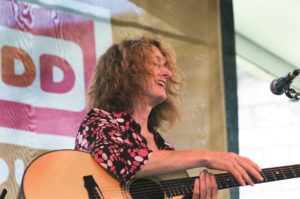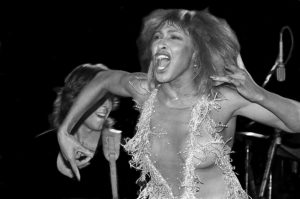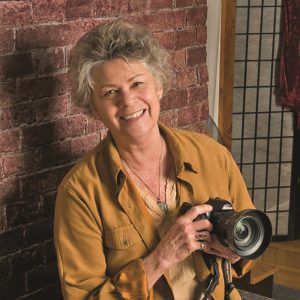If you were to walk down Tremont Street in Boston, you’d come upon a digital show of photographs of women musicians on the marquee of the Boch Center. They’re by Susan Wilson, and they’re on display in March as part of Women’s History Month.
For those of us sheltering in place on the Outer Cape, “the big city” may feel worlds away. But one thing links us directly to the exhibit: Wilson herself.
“I have, since childhood, been in love with Cape Cod,” says Wilson from her Wellfleet home. She has split her time between here and Cambridge since 1990. Growing up in Madison, N.J., she would regularly visit the Cape in the summer.
“History, art, and music have always been a big part of my life,” she says. Wilson went to Tufts three times — for her B.A., M.A., and Ph.D. in history. While going for her graduate degrees, she learned that her scholarship could be applied to classes at the School of the Museum of Fine Arts. So, she got a used 35mm camera and studied photography.

After a year of shooting, a guest lecturer at one of her classes approached her and asked whether she’d be interested in writing about and photographing women musicians for a new women’s newspaper. That’s how she ended up working for Equal Times and Sojourner.
Though photography was relatively new to Wilson, music wasn’t. She’d “flunked piano,” she says, then took up ukulele and, finally, guitar, and was part of the first all-women rock band at Tufts. “You really have to play music to write about it,” says Wilson. But she’d gotten most of her music fix vicariously.
“They’re all nuts, and so am I,” says Wilson of musicians. “I just think they’re really interesting people, and most musicians are doing it because they love it, not because someone said, ‘Hey, that’s a good way to make a living.’ They’re people who live on the edge.”
When she was starting out, photographing at Club Passim, she became friends with “an aspiring musician” and traded publicity photos for guitar lessons. That friend is Patty Larkin, whose image is featured in the Boch Center show. Coincidentally, Larkin later moved to Wellfleet.
“I was shooting all these musicians, and, within a couple of years, the Boston Globe called and asked if I would freelance” as a music critic, says Wilson. It was the ’70s and ’80s, with women musicians coming into their own, and the Globe’s chief rock critic, Steve Morse, saw the need for a woman’s voice. “If a man went out and panned a woman musician, he was called sexist,” Wilson says. “If I went out and panned a woman musician, I would just be called stupid.”

One of the first musicians she reviewed for the Globe was Tracy Chapman. “I don’t believe in discovering people,” says Wilson, but with Chapman, she essentially did. At the time, Chapman didn’t have money for publicity photos, so, in exchange for a shoot, she “agreed to paint my studio and wax my car.”
Most of the photos in the exhibit are pre-digital. Today, shooting is easier, Wilson says, but it’s harder to secure permission. And there are often limitations: you can shoot only the first two songs in a concert, or only from a certain area. If the musician isn’t too famous, you might be able to go backstage.
Concert photography is an especially difficult genre for two reasons: lighting and movement. In order to capture a dark stage, with moving subjects in a spotlight, you need to use sensitive film, which requires a steady hand. “It’s amazing that anyone got anything in focus,” says Wilson.
It also requires thick skin. “Did I ever get yelled at? Yes,” says Wilson. The photographer’s job is “a very focused thing. You experience the concert differently. You need to remember to step back and enjoy being there.”
Wilson got to shoot Tina Turner in the early part of her solo career. It was at the Bradford Hotel in 1981. This was pure luck, Wilson says, as it was “before she hit it big” with “What’s Love Got to Do With It.” The sound of the camera clicking, which can be distracting, wasn’t an issue: “Tina Turner was so damn loud, no one would notice,” Wilson says.

The work kept her busy. Sometimes, Wilson says, she’d be reviewing a concert for the Phoenix and shooting photos for the Globe.
Wilson’s favorite concert? The Newport Folk Festival of 1985. She got a backstage photo of Judy Collins, Joan Baez, and Mimi Fariña, Baez’s sister. There was “an amazing lineup,” Wilson says, including Bonnie Raitt, Arlo Guthrie, and Taj Mahal.
These days, Wilson is mostly retired. Several years ago, she segued into shooting classical musicians. In some ways it’s easier, she says, since “Yo-Yo Ma isn’t going to do something as crazy as Tina Turner.” But classical concertgoers are especially fussy about noise.

“I felt very lucky to have come into this in 1977,” says Wilson. It was just as second-wave feminism was hitting the United States. “Part of my mission was to expose what was a new phenomenon: women emerging in control of their careers.
“We’re not equal yet,” she adds. “But we’re working on it.”
Sister Act
The event: “Women Who Rock”
The time: Throughout March
The place: Boch Center marquee, 270 Tremont St., Boston
The cost: Free



